An official website of the United States government
 United States Department of Labor
United States Department of Labor
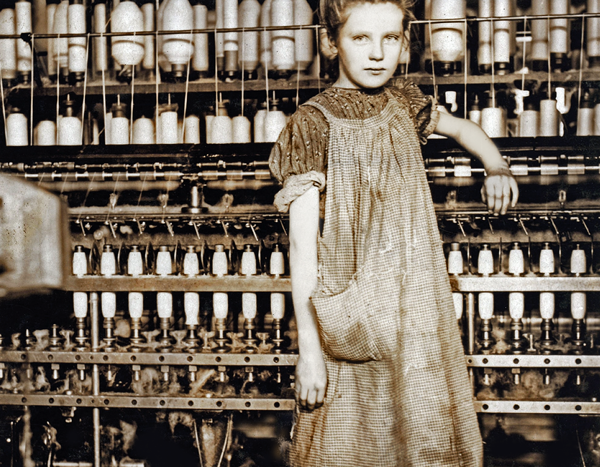
Crossref 0
No Oversight, No Limits, No Worries: A Primer on Presidential Spying and Executive Order 12,333, SSRN Electronic Journal , 2019.
Princesses and Paupers: American Child Labor Revision and Realities in A Little Princess, Hollywood or History?, 2022.
Challenging Federal Oversight of Pharmaceuticals: Preemption Beyond Products Liability, SSRN Electronic Journal, 2015.
Education and Longevity, Handbook of Labor, Human Resources and Population Economics, 2022.
Muckrakıng Through the Novel: Upton Sınclaır’s the Jungle and the Early Hıstory of Human Resources Management, Organizacija, 2024.
Transatlantic Differences in Labour Markets: Changes in Wage and Non-Employment Structures in the 1980s and the 1990s, SSRN Electronic Journal, 2005.
Innovation Policy on a Budget: Driving Innovation in a Time of Fiscal Constraint, SSRN Electronic Journal, 2010.
The federal funds rate effect on subprime mortgage crisis management: An ARDL approach, Journal of Governance and Regulation, 2021.
Unveiling the Realities of Unemployment among BTVTEd Graduates: A Qualitative Insight into their Lived Experiences, Psychology and Education: A Multidisciplinary Journal, 2025.
The 2010 State New Economy Index, SSRN Electronic Journal, 2010.
There was a time in this country when young children routinely worked legally. As industry grew in the period following the Civil War, children, often as young as 10 years old but sometimes much younger, labored. They worked not only in industrial settings but also in retail stores, on the streets, on farms, and in home-based industries. This article discusses the use of child labor in the United States, concentrating on the period after the Civil War through the rise of the child labor reform movement.
The golf links lie so near the mill
That almost every day
The laboring children can look out
And see the men at play.1—Sarah N. Cleghorn
The September 1906 edition of Cosmopolitan magazine recounts a story once told of an old Native American chieftain. The chieftain was given a tour of the modern city of New York. On this excursion, he saw the soaring heights of the grand skyscrapers and the majesty of the Brooklyn Bridge. He observed the comfortable masses gathered in amusement at the circus and the poor huddled in tenements. Upon the completion of the chieftain’s journey, several Christian men asked him, “What is the most surprising thing you have seen?” The chieftain replied slowly with three words: “little children working.”2
Although the widespread presence of laboring children may have surprised the chieftain at the turn of the 20th century, this sight was common in the United States at the time. From the Industrial Revolution through the 1930s was a period in which children worked in a wide variety of occupations. Now, nearly 110 years after the story of the chieftain was told, the overt presence of widespread child labor in New York or any other American city no longer exists. The move away from engaging children in economically productive labor occurred within the last 100 years. As numerous authors on the subject have remarked, “Children have always worked.”3 In the 18th century, the arrival of a newborn to a rural family was viewed by the parents as a future beneficial laborer and an insurance policy for old age.4 At an age as young as 5, a child was expected to help with farm work and other household chores.5 The agrarian lifestyle common in America required large quantities of hard work, whether it was planting crops, feeding chickens, or mending fences.6 Large families with less work than children would often send children to another household that could employ them as a maid, servant, or plowboy.7 Most families simply could not afford the costs of raising a child from birth to adulthood without some compensating labor.8
One of the authors who noted that “children have always worked” is Walter Trattner.9 During early human history when tribes wandered the land, children participated in the hunting and fishing. When these groups separated into families, children continued to work by caring for livestock and crops. The medieval guild system introduced children to the trades. The subsequent advance of capitalism created new social pressures.10 For example, in 1575, England provided for the use of public money to employ children in order to “accustom them to labor” and “afford a prophylactic against vagabonds and paupers.”11 An Englishman stated, with regret, that “a quarter of the mass of mankind are children, males and females under seven years old, from whom little labor is to be expected.”12 This statement was consistent with the Puritan belief that put work at the center of a moral life.13 This belief shaped a citizenry that grew to praise work and scorn idleness.14 The growth of manufacturing, however, provided the greatest opportunity for society to avoid the perceived problem of the idle child.15 Now that more work was less complex because of the introduction of machines, children had more potential job opportunities. For example, one industrialist in 1790 proposed building textile factories around London to employ children to “prevent the habitual idleness and degeneracy” that were destroying the community.16 With the advances in machinery, not only could society avoid the issue of unproductive children, but also the children themselves could easily create productive output with only their rudimentary skills.
Similarly, in America, productive outlets were sought for children. Colonial laws modeled after British laws sought to prevent children from becoming a burden on society.17 At the age of 13, orphan boys were sent to apprentice in a trade while orphan girls were sent into domestic work.18 Generally, children, except those of Northern merchants and Southern plantation owners, were expected to be prepared for gainful employment.19 In other locations, the primary motivation in employing children was not about preventing their idleness but rather about satisfying commercial interests and the desire to settle the vast American continent.20 Regardless of the motivation, a successful childhood was seen as one that developed the child’s productive capacity.21
As economic tensions increased between England and the American colonies, the desire for an independent manufacturing sector in America became more pronounced. By manufacturers employing women and children in this pursuit, the man of the household could still tend the farm at home. This practice helped fulfill the Jeffersonian ideal of the yeoman farmer.22 Child labor also served the Hamiltonian commercial vision of America, by providing increased labor to support industry.23 In accordance with this vision, Alexander Hamilton, as Secretary of the Treasury, noted in a 1791 report on manufacturing that children “who would otherwise be idle” could become a source of cheap labor.24
Around the same time, the influential Niles’ Register (a national newsweekly magazine) noted that factory work was not for able-bodied men, but rather “better done by little girls from six to twelve years old.”25 Industrialists viewed progress as having machines so simple to operate that a child could do it.”26 This labor was perceived as beneficial not only to the child but also to the public as a whole. In keeping with this ideal of child productivity, an 1802 advertisement in the Baltimore Federal Gazette sought children from the ages of 8 to 12 to work in a cotton mill. The ad stated, “It is hoped that those citizens having a knowledge of families, having children destitute of employment, will do an act of public benefit by directing them to the institution [cotton mill].”27 In New England, the allure of employing children in the mills was thought by one editorial writer to be so strong that it led parents to choose its settlements versus the less developed Western frontier where no such job opportunities existed.28 By 1820, children made up more than 40 percent of the mill employees in at least three New England states.29 That same year, Niles’ Register calculated that if a mill were to employ 200 children from the age of 7 to 16 “that [previously] produced nothing towards their [own] maintenance . . . it would make an immediate difference of $13,500 a year to the value produced in the town!”30
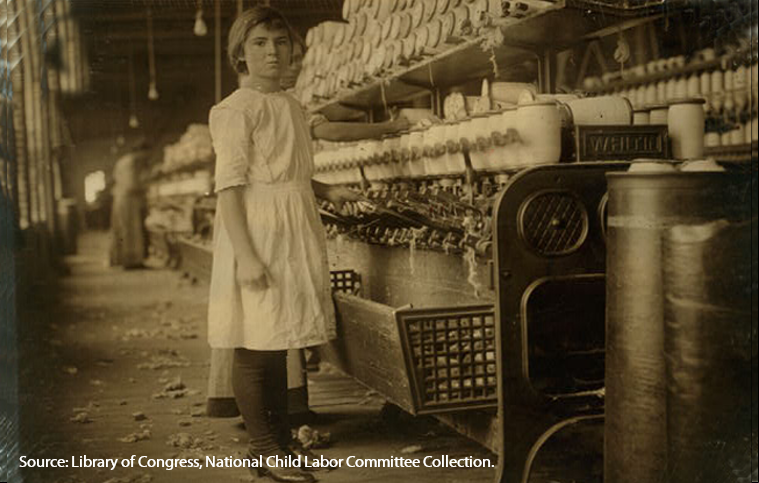
Although the economic value of work for children was emphasized, its perceived underlying benefit was also important in its growth in the 19th century. This value was seen in the nature of the outreach that some organizations such as the Charles Loring Brace Children’s Aid Society (CAS) provided to orphaned children. In establishing its first lodging house for boys in 1854, the CAS emphasized that it would “treat the lads as independent little dealers and give them nothing without payment.” Through avoiding the prospect of idle children, CAS thought it was avoiding “the growth of a future dependent class.”31 It believed that the best way to bring children out of poverty was to have them work at an “honest trade.” To do this, the CAS taught children work skills such as the trade of shoemaking.32 Finding that New York City did not have enough “honest jobs,” the CAS established trains to move orphaned children out West.33 This movement was seen as balancing the supply of youth in the cities with the demands found in rural areas.34 The CAS received further support from abolitionist forces that saw this “free labor” of children as a donation to the cause of “freedom” in the fight against slave labor in the West.35 The success of these children was judged by how much they worked for the Western families that took them in. In annual reports, the CAS published letters that highlighted the productive capacity of the children. These letters reported things such as how the child “does nearly as much as a man” or was earning his keep.36
The parallel beliefs that labor benefited children by helping them avoid the sin of idleness and economically benefited society by helping it increase its productive capacity fueled the spread of the practice. Women and children dominated pre-Civil War manufacturing; however, the low volume of manufacturing caused the number of children employed to remain at low levels.37 The advances in manufacturing techniques in the post-Civil War years increased opportunities for children and led society to take advantage of this productive capacity. Similarly, some of the productive capacity that had been met by the use of slaves was met by women and children in the years following emancipation.
However, in the period immediately following the Civil War, “free labor” was not always clear when recently freed slave children and some immigrant youths were considered. In many cases, former slave children were functionally reenslaved through apprentice agreements, which bound the child to the former slave master. In these agreements, the parent exchanged the labor of the child in return for “training” provided by the former slaveowner.38 These agreements were frequently seen by courts as beneficial to the child because the slave master was in a better position to teach the child “the habits of industry” than were the recently freed parents.39 Although these situations were eventually remedied in the South during the Reconstruction period, similar abuses of the apprentice system occurred elsewhere. In New York City, in the 1870s, the operation of Italian “padrones” (persons who secured employment especially for Italian immigrants) bordered on child slavery under the guise of apprenticeship. The padrones often deceived Italian children and parents (those residing in Italy) into apprentice arrangements, purportedly for teaching the child how to play a musical instrument. Once agreements were signed, the children were swept off to America where they were forced to become street performers with all of their earnings provided to the padrone. Children who failed to comply with the demands of their padrone master were frequently beaten.40 As the New York Times put it in 1873, “The world has given up on stealing men from the African coast, only to kidnap children from Italy.”41
Although the situations involving former slaves and the Italian padrones were egregious, they were a small percentage of the overall number of working children. As child labor expanded through the end of the 19th century, these practices diminished. The 1870 census found that 1 out of every 8 children was employed.42 This rate increased to more than 1 in 5 children by 1900.43 Between 1890 and 1910, no less than 18 percent of all children ages 10‒15 worked.44 Age was only one consideration in deciding whether a child was ready for work. Being “big enough to work” was usually not a metaphor about reaching a certain birthday; rather it was often about the physical size of the child as well as the acumen the child appeared to have in performing the labor required.45 Age and size, however, were not the only factors that determined whether a child worked. Distinctions between children expected to work and those not expected to work made on the basis of family income became increasingly evident. Children from families at the lower end of the class spectrum were frequently employed, whereas the concern about idle youths did not appear to be one shared by the upper classes. As one well-to-do father explained in 1904, “We work for our children, plan for them, spend money on them, buy life insurance for their protection, and some of us even save money for them.”46 At the lower end of the income scale though, families were forced to use their children for their labor without the luxury of saving for their futures.
By the turn of the 20th century, the labors that the children of the working class performed were varied. In rural areas, young boys, some reportedly under age 14,47 toiled in mines, sometimes working their fingers literally to the bone, breaking up coal.48 Young lads in urban areas often earned their living as newspaper carriers or as couriers. In many towns, mills and glass factories regularly employed girls and boys.49 Young children worked in the fields performing farm labor and on the coasts in the seafood industry. Even youngsters who never left the house had employment options. Home-based businesses provided children a chance to labor by assembling flowers or other items.50 With so many avenues available for employment, children were seen as a resource, rather than a drain, to many parents who were struggling financially.51
At the turn of the 20th century, children were working in various industries. The discussion that follows highlights some of the occupations in which children labored and examines the employment conditions children faced in detail.
As the story of the chieftain illustrates, working children were a widespread presence in urban areas because of the number of occupations they performed. Most visibly, many engaged in occupations working on city streets.52 These children sold newspapers, shined shoes, and carried messages. In the days before the Internet, texting, and even the telephone, these messengers provided the easiest way for people within an urban area to communicate. In this role, they became essential to daily commerce for banks, factories, and offices. At night, they provided these same essential services to brothels and those enterprises conducting other unlawful activities.53 Similar, less tawdry courier services were provided within department stores. Children known as “cash” boys and girls carried money, sales slips, and items purchased to store inspectors. The inspectors wrapped the goods and verified the amounts paid. The children then returned the change and the items.54
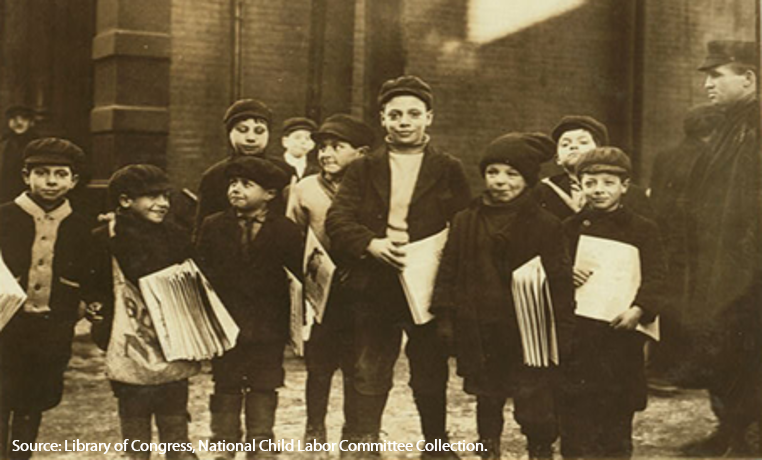
While courier boys were common, newspaper boys, popularly known as “newsies,” worked in the most visible of the street trades and were the face of child labor for most urban Americans.55 According to author Hugh Hindman, saying that most urban kids worked as a newsboy for at least a short period is no exaggeration.56 After buying their papers from the publisher, the newsies would hawk papers on street corners. This arrangement meant that the carriers only profited when they sold a paper. This situation led to fierce competition between the carriers for the best locations. On big news days, a flashy headline helped drive sales of papers; however, on other days, the newsboys needed to use more nefarious means to profit from sales.57 These techniques included shouting out false headlines and shortchanging customers, particularly during the late-night hours.58 During World War I, the shouting of false headlines was such a nuisance that Cleveland, Ohio, threatened to prosecute boys who shouted “false and amazing” statements. In New York City, an October 1917 New York Times article outlined the efforts of police to stop carriers from shouting baseless headlines of war calamities to spur sales.59 Yet, the same article noted that when these enterprising youngsters were hauled before the judge, the police officers were likely lectured for not devoting their time to more serious crimes.60
The newsies also frequently took advantage of the kindness of strangers through their use of the “last-paper ploy.” In such a ploy, the youngster feigned cold, exhaustion, or hunger saying that he or she could go home only by selling the last paper. Once a sympathetic purchaser left with the paper, the newsie pulled out another paper from a hidden stash and used the ploy again.61 Despite devious schemes like these, among themselves, the newsies generally developed a cohesive culture. Rather than picking on the youngest carriers, the older and larger lads frequently looked out for their younger competitors.62
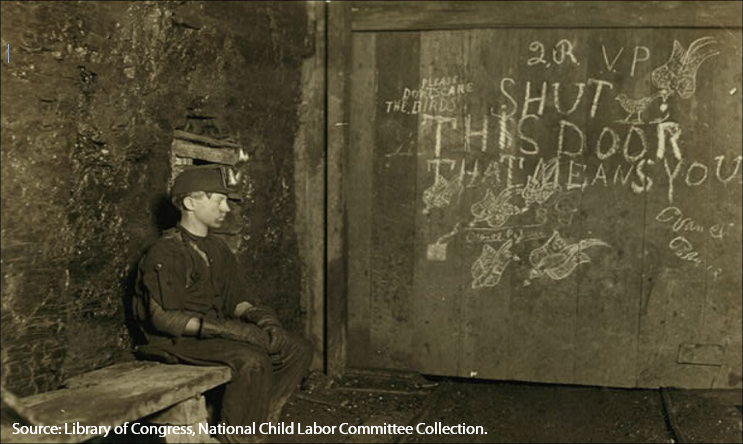
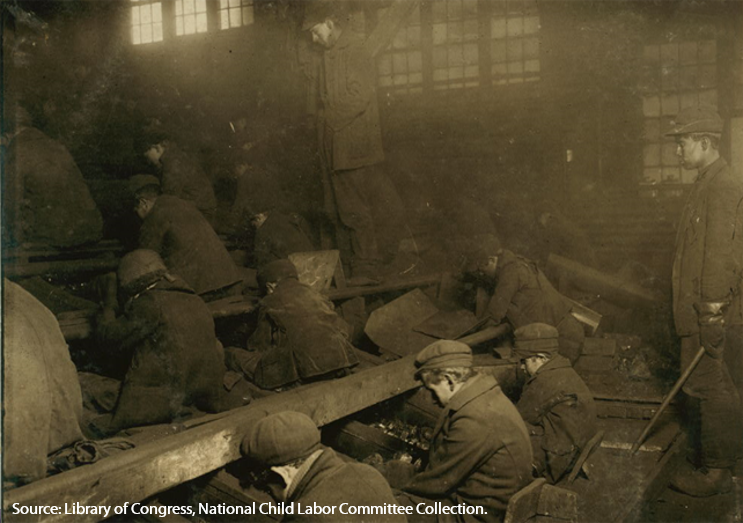
Although many child laborers, such as the newsies, worked in plain view of others on city streets, many did not. While their coal-stained faces have now become known through pictures, at the time, the children who worked in mines labored in relative obscurity. Some labored in the mines as “trappers,” others were known as “breaker boys,” and many worked as “helpers.” The trapper’s sole job was to sit all day waiting to open a wooden door to allow the passage of coal cars. These doors, which were part of the mine’s ventilation system, required opening between 12 and 50 times a day. During the rest of the time, the boy sat in dark idleness next to the door.63 Although less monotonous, the job of the breaker boys was likely more dangerous. Their job was to use a coal breaker to separate slate and other impurities from coal before it was shipped. To do so, these boys, some as young as 14, were precariously position on wooden benches above a conveyor belt so they could remove the impurities as the coal rushed by.64 At times, the dust from the passing coal was so dense that the view would become obscured.65 Other child coal laborers worked as helpers. Journeymen miners frequently hired their own helpers, and some parents hired their own children to perform this role. These children were not usually employees of the mine but were instead paid out of the wages of the journeymen.66
Although the coal industry was vital in many sections of the country, perhaps most prominent among the child-labor-intensive industries was the cotton mill. In 1900, 25,000 of the nearly 100,000 textile workers in the South were children under 16. By 1904, overall employment of children had increased to 50,000, with 20,000 children under 12 employed. The family, particularly the women and children, was central to mill operation.67 The Southern mill and the labors associated with it are iconic. Pictures of young girls in the mill are likely those most identified with child labor in America.68
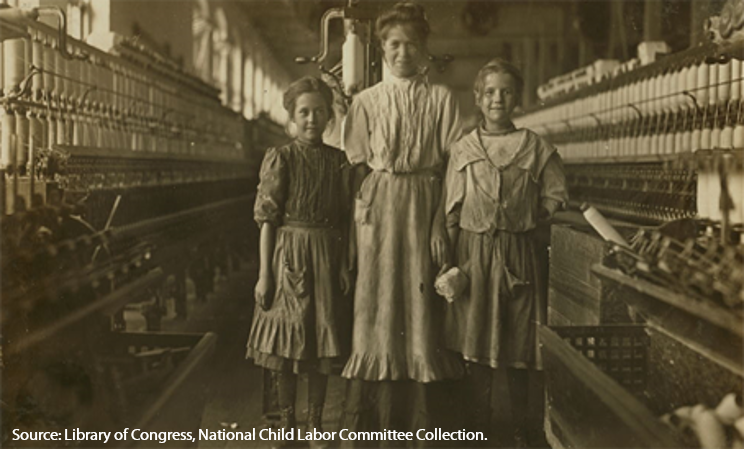
Following the Civil War, the cotton mill industry, based partially on child labor, was responsible for raising many Southern white families out of poverty.69 These mills almost exclusively employed white children because of an implicit agreement between the manufacturers and planters. This pact ensured that planters remained in control of the rural black labor supply.70 Some early historians believed that the altruistic motive of helping the white children avoid idleness was the mill owner’s primary purpose in operating the mills. As one mill owner remarked, working 12-hour days, 6 days a week left children “no time to spend in idleness or vicious amusements.”71 Later historians acknowledged that the profit motive was the owner’s primary driver.72 Regardless of their goal, mill owners saw children as a primary requirement to operating a successful mill. For example, prominent South Carolina mill owner Lewis W. Parker described the rationale for the use of child labor in the mill as follows:
The unfortunate families back in the backwoods drifted to the cotton mills. When they drifted to the cotton mills, what was to be done? It is not possible for a man who has been working on a farm, who is an adult—after the age of 21 years, for instance—to become a skilled employee in a cotton mill. His fingers are knotted and gnarled; he is slow in action whereas activity is required in working in the cotton mills. Therefore, as a matter of necessity, the adult of the family had to come to the cotton mill as an unskilled employee, and it was the children of the family who became skilled employees in the cotton mills. For that reason, it was the children who had to support the families for the time being. I have seen instances in which a child of 12 years of age, working in the cotton mills, is earning one and one-half times as much as his father.73
Through this logic, mill owners rationalized that the employment of children was supporting the entire family, even if the child was the only family member employed.
Just as the mill was important to the individual family, it was similarly important to many Southern towns in supporting the entire commercial ecosystem.74 The mill owner provided schooling, stores, and housing for the mill families.75 When workers fell into debt, they could put their children to work to pay the mill owner their living expenses. Despite this arrangement, according to the records from one early 19th century cotton mill, families frequently were in debt to the mill once store purchases and rent payments were deducted.76 Large households, however, increased income to the family and were seen as a benefit to the mill owner. Even children too young to work were viewed as an investment in the future productive capacity for the mill. Oftentimes, contractual arrangements with the head of the household bound the family to provide labor.77 In many cases, that agreement included a set quota for the amount of labor the family was to provide.78 The mill might provide schooling for children from the ages of 5 to 12, but at the age of 12, the children were required to start their working life in the mill. Not just mill owners insisted upon this arrangement. Many parents believed that they should begin receiving some money back on their investment once a child reached the age of 10 or 12.79 Thus, the actions of both the mill owner and the parents contributed to the widespread use of child labor in cotton mills. While owners were attempting to pull children into the factory, parents were eagerly pushing the children out of the nest and into productive employment.
This push of the children into mill work started even before they were old enough to competently work on their own. Children who were too young to work independently assisted others as helpers. This “helper system” enabled children younger than 10 to assist their mothers with any minor chores required at the mill.80 These children, though, did not earn their own wage. Because of their limited skills, they were frequently seen as being unprofitable to employ at any wage.81 Mill owners, however, saw that the presence of these children in the mill benefited the parent. This welcoming of children in the workplace was also in the long-term interest of the mill owner because the children could familiarize themselves with their future workplace.82 At recess during the school day, other children helped by bringing their parents and older siblings meals.83 In many cases, these same children soon made their way to the mill working full time. Usually the boys started as doffers and sweepers while the girls were spinners.84 Doffers replaced the full bobbins filled by spinners with empty ones and often had hours of free time in between their required tasks at the mill.85 These tasks were usually seen as children’s work, whereas other heavier work, such as oiling machinery, was seen as “men’s work.” In the mill, as in most other factory industrial settings at the time, work appropriate for children was clearly differentiated from work seen as appropriate for adults.86 Although mill supervisors oversaw the children who performed these child-appropriate tasks, they were often reluctant to discipline the children. In many ways, the mill was seen as an extension of the family unit. Therefore, for any trouble that the children caused at work, mill owners usually left their discipline up to the parents.87 This approach illustrates just how closely the mill was integrated into the family structure.
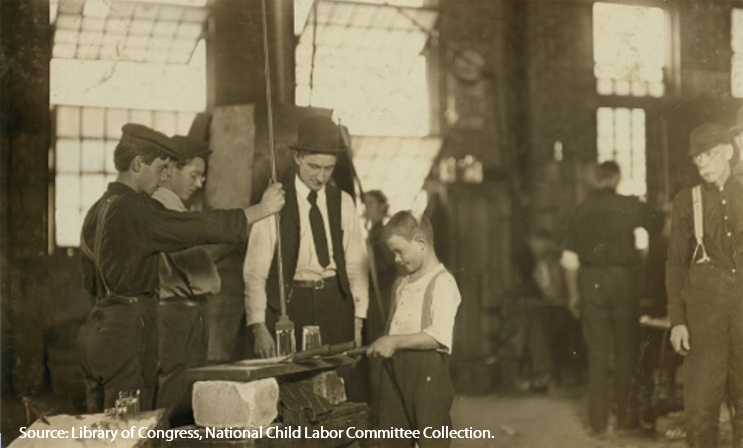
Although central in the history of child labor, the cotton mill was not the only manufacturing operation in which the children toiled. Boys took their place in light manufacturing in industries such as glass bottle production. Their small hands made them ideal to perform tasks such as the cleaning of bottles.88 In some areas of the Midwest United States, such as the East St. Louis region of Illinois that by 1910 had a high concentration of glassworks, a boy shortage existed. In response to this lack of labor, factories hired “boy getters.” These agents recruited boys throughout the Midwest to the factory either alone or with their families. Boys could be obtained from orphanages from as far away as New York City. Trains of orphans and other vagrant children arranged by the Charles Loring Brace CAS ended up being a conduit into the factories.89 This finding is ironic since these trains were sponsored by the CAS, which sought to protect children from the ravages of the inner-city labor market by providing opportunities for them to earn an “honest living” in a rural setting.90 Rural life was believed to provide more opportunities for advancement.91
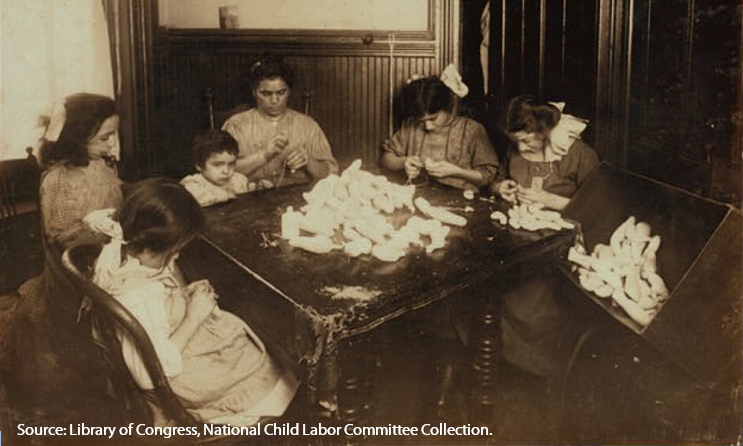
While many children found employment in the mill, in the factory, or on the streets, others worked in the home. Rather than being a respite from the toil of school, home for some children meant labor. As one 7-year-old told a child-labor investigator, “I like school better than home. I don’t like home. There’s too many flowers.”92 Flowers, brushes, and clothing were the sorts of goods that began to be produced through home production in the late 19th century. Concentrated around New York’s garment factories, home workshops gave manufacturers an inexpensive alternative to factory labor when looking to produce easily assembled goods. A middleman known as “a sweater” frequently secured the home-based laborers and provided their produce to the manufacturers. These manufacturers benefited from this arrangement, under which these workers were paid an estimated one-third the wages of those in factories.93 These home-based businesses provided additional productive capacity to industry and were convenient for women caring for small children and did not desire to leave the home. Once those same children reached a productive age, they could easily assist with the work and help the family increase its earnings, which were commonly based on the number of items produced. This practice also let children work under the watchful eye of a parent without the children having to venture outside the home.
Similarly, farm labor historically had its roots as a home-based undertaking. Children had long had a place in domestic farming, unlike mill and factory work that grew out of the Industrial Revolution.94 During the Gilded Age (period between the Civil War and World War I when the United States population and economy grew quickly), two-thirds of child labor was done on the farm. As farms grew and shifted away from the family farm model of agriculture, children continued to support farming. In 1900, 6 out of 10 male farmhands were sons of the farmer. Although some required farm duties had become increasingly mechanized, most tasks were still largely done by hand. The child was unlikely to interface with the operation of heavy machinery on a large scale, unlike in factory settings.95 Children on farms provided a beneficial source of manual labor; as one farmer remarked, “Every boy born into a farm family was worth a thousand dollars.”96 If their labors were not needed on their family’s farm, children could usually find employment as a hired hand on a neighboring farm. For families without a farm of their own, oftentimes the entire family was hired to work as farmhands. Children sometimes as young as 3 years old could be found hulling berries.97 One review of the ages of child cranberry pickers in New Jersey in 1910 found that most children were between 8 and 10 years old. These children accounted for as much as an estimated one-third of the entire harvest.98 More broadly, one study found that one-fourth of those employed under the age of 16 in agriculture were under 10 years of age.99 While some children harvested crops, on the Gulf Coast others shucked oysters and picked shrimp.100
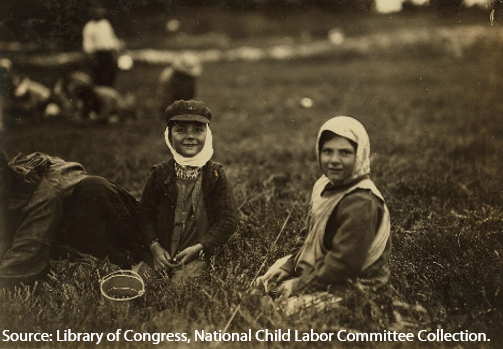
The seasonal need of these outdoor industries required getting laborers to the right place at the right time. To meet this need, industry owners used a padrone system. Although generally less nefarious than the Italian musical padrone system, like sweaters in the textile environment, the padrones were middlemen hired by the farmowner to recruit needed labor. The padrone was paid a certain rate per unit of output and in turn subcontracted with the laborer. This practice was most efficiently done when large families were available. In these cases, the padrone could secure a family rate.101 In the South, children from the age of 6 or 7 were expected to help the family work the land.102 Regardless of whom in the family worked, or how old they were, the family received a fixed rate per bushel of berries picked or bushel of oysters shucked.103 Children in farming were seldom paid directly for their labor. Their wages were included in the amount paid to the family.104 This system made the head of the household responsible for oversight of all the laborers in the family and allowed the padrone only to deal with a minimum number of subcontractors.105 Under such an arrangement, a child, therefore, was an integral part of the productive capacity of the household.
Although children in the post‒Civil War United States labored in a variety of occupations, the legal foundation that allowed parental control was unwavering, regardless of the field of employment. The right of parents to take advantage of the productive capacity of their children was long recognized both in the United States and abroad. William Blackstone, an 18th-century English jurist, noted that a child is the property of his father.106 The toil of children during the Industrial Revolution was consistent with this belief. Seldom were questions raised about the right of the father to benefit from the labors of his offspring. This practice was simply seen as one of the natural privileges of parenthood.107 The perceived value of the child can be viewed through how the legal system treated the wrongful death of a child and the damages the parents could hope to recover. Courts of that period usually found that the proper amount due was “the probable value of the services of the deceased from the time of his death to the time he would have attained his majority, less the expense of his maintenance during the same time.” These awards often involved testimony from child employers who outlined the wages commonly paid.108 These courts recognized what was well understood: the parent naturally benefited from the productive labors of his child until the child reached the age of majority.
Consistent with the concept of parental ownership of the work of their offspring, generally, the wages the child earned served the common purpose of supporting the family. This payment of wages happened directly in cases in which the family was working on a collective piece-rate basis; in cases in which the child earned independent wages, these wages were usually turned over to the parents as well.109 The wages that the supervisor offered in many physically demanding occupations frequently varied on the basis of the physical size of the child.110 Although a fraction of child laborers, some as young as 10,111 negotiated their pay directly with their employer, a parent or guardian frequently negotiated it.112 In either case, once earned, these wages generally became the property of the parents. Often, these wages were the key to survival for many working-class families. One analysis of Philadelphia families, for instance, found that for native-born two-parent families, children contributed between 28 and 33 percent of the household income. For Irish and German families living in Philadelphia, these numbers were as high as 46 and 35 percent, respectively. Rather than the wife being the secondary wage earner, as became the case decades later, for many families in the late 19th century, the child performed this role.113
Even among children in the street trades, who operated most independently from their parents, one study of 106 newsboys found that nearly all of them gave their earnings to their mother or father.114 Consistent with legal thinking at the time, the belief of parents was that any money that the child earned was to first be provided to them. Once that was done, the parent might allocate a small amount to the child as an allowance to allow him or her to make a particular purchase. Children were incentivized to work, because in many cases, work meant money back for clothes, soda water, and other amusements.115 Among the newsies, one study conducted in St. Louis found that 87 percent of them “frequented movie picture shows and cheap theaters.”116 Allowing children, however, to have control of their money was seen by many parents as eliminating the distinctions between children and adults, which was thought to have ruinous consequences. Society, at the time, saw this notion as eliminating the hierarchical structure on which the parent-child relationship was based.117 Although children could earn money as grownups could, their role in the household was unchanged by their economic contributions. Society viewed them simply as an extra money-earning appendage of the mother or father. Just as the parents had a right to earn money from the labors of their own hands, they were entitled to the earnings of their offspring.
Although the belief was widespread that the parents should have complete control over the economic affairs of the child, not everyone agreed with this logic. For some, this control reduced the child to a creature with only economic value. This concern was even shared by a few in the legal system who spoke out against valuing the life of a child on the basis of expected monetary contributions to the family. For example, in Schendel versus Bradford, a 1922 case involving the death of a child, the presiding judge protested, “This cold-blooded calculating measure of human life . . . . Awarding pecuniary damages to the next of kin of a child six years of age is merely making a business commodity out of the child and subjecting the loss of that child’s life to a dollars and cents argument.”118
Thinking of the children as more than just their economic value eventually helped change the role of the children of the working class in American society.119 In combination with a greater awareness of the exploitive practices of some employers, this change in thinking helped propel reform efforts that, in time, led to an end of widespread child labor in the United States. However, reformers faced a long, uphill battle against employers, parents, and the legal system in securing nationwide reform. The legal system, primarily the Constitution and the limited scope of powers it granted to the federal government, proved to be a primary challenge to reform. By the end of the 19th century, the Supreme Court had not heard a single case about child labor. Child labor was a matter for the states to deal with under their own laws, which, in many cases, did not regulate (or barely regulated) child labor. As a result, decades would pass before an observant chieftain would be able to express his surprise at the newfound lack of working children in New York and throughout United States. Part II of this article will detail how the reformers, after decades of struggle, finally succeeded in bringing about this decline in child labor.
Michael Schuman, "History of child labor in the United States—part 1: little children working," Monthly Labor Review, U.S. Bureau of Labor Statistics, January 2017, https://doi.org/10.21916/mlr.2017.1
1 Hugh D. Hindman, Child labor: an American history (Armonk, New York: M.E. Sharp, 2002), p. 153.
2 Edwin Markham, “The child at the loom,” Cosmopolitan, September 1906, pp. 80‒87.
3 Hindman, Child labor, p. 6.
4 Viviana A. Zelizer, Pricing the priceless child: the changing social value of children (Princeton, New Jersey: Princeton University Press, 1994), p. 5.
5 Hindman, Child labor, p. 46.
6 Chaim M. Rosenberg, Child labor in America: a history (Jefferson, North Carolina: McFarland and Company Inc., 2013), p. 4.
7 David Nasaw, Children of the city: at work & at play (Garden City, New York: Anchor Press/Doubleday, 1985), p. 42.
8 Ibid.
9 Walter I. Trattner, Crusade for the children: a history of the National Child Labor Committee and child labor reform in America (Chicago: Quadrangle Books, 1970), p. 21.
10 Ibid., pp. 21‒22.
11 Ibid.
12 Ohio Council on Woman and Children in Industry, “Child labor,” in Julia E. Johnsen, ed., Selected articles on child labor (New York: H.W. Wilson Company, 1925), p. 11.
13 Hindman, Child labor, p. 46.
14 Rosenberg, Child labor in America, p. 3.
15 Ohio Council on Woman and Children in Industry, p. 16.
16 Rosenberg, Child labor in America, p. 35.
17 Hindman, Child labor, p. 46.
18 Rosenberg, Child labor in America, p. 3.
19 Ibid.
20 Hindman, Child labor, p. 46.
21 Ruth Wallis Herndon and John E. Murphy, “A proper instructive education: raising children in pauper apprenticeship,” in Ruth Wallis Herndon and John E. Murphy, eds., Children bound to labor: the pauper apprentice system in early America (Ithaca, New York: Cornell University Press, 2009), p. 4.
22 Jefferson had a low opinion of the manufacturing state and the dependency that he believed went along with it. Farming allowed self-sufficiency, whereas manufacturing caused a reliance on others and created an economic hierarchy. Hamilton, on the other hand, believed manufacturing was key to the security of the nation and championed the federal government’s support of it. For more on this topic, see John Ferling, Jefferson and Hamilton: the rivalry that forged a nation (New York: Bloomsbury Press, 2013).
23 Hindman, Child labor, p. 46.
24 Rosenberg, Child labor in America, p. 4.
25 Trattner, Crusade for the children, p. 26.
26 Ohio Council on Woman and Children in Industry, p. 11.
27 Trattner, Crusade for the children, p. 27.
28 Ibid.
29 Ibid.
30 Zelizer, Pricing the priceless child, p. 60.
31 Marjorie E. Wood, “Emancipating the child laborer: children, freedom, and the moral boundaries of the market in the United States, 1853‒1938” (Ph.D. diss., University of Chicago, 2011), p. 32.
32 Wood, “Emancipating the child laborer,” p. 42.
33 Ibid.
34 Ibid., p. 43.
35 Ibid., p. 45.
36 Ibid., p. 46.
37 Hindman, Child labor, p. 47.
38 Wood, “Emancipating the child laborer,” p. 69.
39 Ibid., p. 80.
40 Ibid., p. 69.
41 Ibid., p. 65.
42 Zelizer, Pricing the priceless child, p. 6.
43 Hindman, Child labor, p. 31.
44 Katharine DuPre Lumpkin and Dorothy Wolff Douglas, Child workers in America (New York: Robert M. McBride & Company, 1937), p. 17.
45 James D. Schmidt, Industrial violence and the legal origins of child labor (Cambridge: Cambridge University Press, March 2010), p. 23.
46 Zelizer, Pricing the priceless child, p. 5.
47 Hindman, Child labor, p. 91.
48 Hindman, Child labor, p. 5.
49 Ibid.
50 Ibid.
51 Zelizer, Pricing the priceless child, p. 6.
52 Hindman, Child labor, p. 215.
53 Ibid., pp. 216‒217.
54 Nasaw, Children of the city, p. 43.
55 Hindman, Child labor, p. 215.
56 Ibid., p. 233.
57 Ibid., p. 230.
58 Nasaw, Children of the city, p. 78.
59 Ibid.
60 “Police move to stop the noise of newsboys,” New York Times, October 4, 1917, ProQuest Historic Newspapers.
61 Nasaw, Children of the city, p. 84.
62 Ibid., p. 158.
63 E.N. Clopper, Child labor in West Virginia, pamphlet 86 (Washington, DC: National Child Labor Committee, 1908), https://id.lib.harvard.edu/curiosity/women-working-1800-1930/45-990092395510203941.
64 Hindman, Child labor, p. 91.
65 Ibid., p. 92.
66 Schmidt, Industrial violence and the legal origins of child labor, p. 14.
67 Rosenberg, Child labor in America, p. 170.
68 Ibid., p. 13.
69 Ibid.
70 Wood, “Emancipating the child laborer,” p. 134.
71 Ibid., p. 13.
72 Hindman, Child labor, p. 54.
73 Ibid., p. 54.
74 Rosenberg, Child labor in America, p. 170.
75 Hindman, Child labor, pp. 157‒158.
76 Robert Hamlett Bremner, Children & youth in America: a documentary history (Cambridge: Harvard University Press, 1970), p. 147.
77 Hindman, Child labor, pp. 157‒158.
78 Trattner, Crusade for the children, p. 38.
79 Hindman, Child labor, pp. 157‒158.
80 Ibid., p. 158.
81 Rosenberg, Child labor in America, p. 13.
82 Hindman, Child labor, p. 158.
83 Ibid., p. 159.
84 Ibid., pp. 161‒162.
85 Ibid., p. 161.
86 Schmidt, Industrial violence and the legal origins of child labor, p. 18.
87 Hindman, Child labor, p. 158.
88 National Archives, “Teaching with documents: photographs of Lewis Hine: documentation of child labor,” National Archives Teachers’ Resources, http://www.archives.gov/education/lessons/hine-photos/.
89 Ibid., p. 125.
90 Wood, “Emancipating the child laborer,” p. 31.
91 Ibid.
92 Hindman, Child labor, p. 187.
93 Ibid., pp. 189‒191.
94 Ibid., p. 255.
95 Schmidt, Industrial violence and the legal origins of child labor, p. 5.
96 Rosenberg, Child labor in America, p. 101.
97 Hindman, Child labor, p. 255.
98 Ibid., p. 257.
99 Lumpkin and Douglas, Child workers in America, p. 60.
100 Hindman, Child labor, p. 268.
101 Ibid., p. 276.
102 Lumpkin and Douglas, Child workers in America, p. 88.
103 Hindman, Child labor, p. 276.
104 Lumpkin and Douglas, Child workers in America, p. 67.
105 Hindman, Child labor, p. 276.
106 Rosenberg, Child labor in America, p. 45.
107 Ohio Council on Woman and Children in Industry, p. 25.
108 Zelizer, Pricing the priceless child, p. 142.
109 Ibid., pp. 58‒59.
110 Schmidt, Industrial violence and the legal origins of child labor, p. 26.
111 Ibid., p. 17.
112 Ibid., p. 12.
113 Zelizer, Pricing the priceless child, pp. 58‒59.
114 Hindman, Child labor, p. 234.
115 Schmidt, Industrial violence and the legal origins of child labor, p. 31.
116 Nasaw, Children of the city, p. 126.
117 Ibid., pp. 130‒131.
118 Zelizer, Pricing the priceless child, p. 152.
119 Ibid., p. 219.